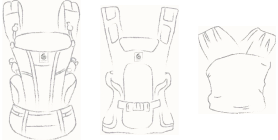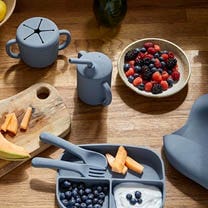
If you are currently deciding what you want for your birth or simply want to find out more about the different types of birth, then you've come to the right place. Because today we’re sharing everything you need to know about caesarean sections (also called a C-sections or abdominal birth), especially compared to a vaginal birth. Particularly looking at the pros and cons of each path to help you decide whether a vaginal birth or c-section is right for you and your baby.
What is a caesarean section?
So what’s the difference technically speaking? A vaginal birth is when a baby is born through the vagina. Labour may begin spontaneously and continue until the baby is born, but in some cases labour needs to be started by induction. In comparison, a caesarean section, or C-section, is an operation to deliver your baby through a cut made in your tummy and womb. Here’s a brief summary of the differences between the two, with more detail later on.
-
Procedure
Caesarean section: A surgical procedure in which the baby is born through an incision in the birthing person’s abdominal wall and uterus.
Vaginal birth: Baby is born through the vagina either spontaneously or through a vaginal surgical procedure, such as a suction cup.
-
Risks
Caesarean section: A caesarean section is a major abdominal operation. As with any operation, there is a risk of infection, haemorrhage, injury to organs, increased blood loss, etc. and complications could also occur in future pregnancies and births.
Vaginal birth: A spontaneous vaginal birth is lower risk but it can lead to birth injuries such as perineal tears and vaginal injuries etc.
-
Plannable
Caesarean section: A caesarean section can be planned if there are medical or psychological reasons to do so.
Vaginal birth: The timing of a vaginal birth is less predictable and labour usually starts spontaneously or is artificially induced.
Why might a planned caesarean section be necessary?
Before we come to the advantages and disadvantages of a caesarean section, we would like to share in a little more detail some of the situations where a caesarean section becomes necessary, sensible or possible. This is because an abdominal birth - whether a planned caesarean section or a spontaneous one - can have a whole range of medical or individual reasons. This list is not exhaustive but here are the most common ones:
- Position of the baby: If your baby is in a breech (bottom or feet down) position or lying transversely (sideways) in your abdomen by 36 weeks your midwife and obstetrician will discuss options for a safe delivery. They will usually offer to try to turn the baby into a head-down position. If this does not work, you'd need to discuss whether a vaginal birth or caesarean section is the best choice.
- Previous births or operations: Most people who have had a caesarean section can safely have a vaginal delivery for their next baby, known as vaginal birth after caesarean (VBAC). But sometimes another caesarean may be necessary. Your midwife or obstetrician will discuss this with you.
- Placenta problems: If your gynaecologist diagnoses a placenta praevia (the (placenta is near or covering the cervix) your baby can't be delivered through the vagina, so a caesarean section will be recommended. If your placenta detaches near your due date (placental abruption), your baby will need to be born straight away and a caesarean section may be recommended.
- Multiple pregnancies: Twins, triplets, quadruplets or more are often delivered by planned caesarean section. Especially if they are in unfavourable positions.
- Cessation of labour: If your spontaneous birth is not progressing and your cervix is not opening any further, a caesarean section is often performed. However, if your baby's head has already made it through the birth canal, the birth can also be terminated using a suction cup or forceps.
- Health problems of the birthing parent: If you suffer from serious illnesses such as pre-eclampsia, heart problems or infections (e.g. an active genital herpes infection, HIV), a planned caesarean section will likely be offered as the safest choice for you and baby.
- Child's health: If your baby shows any signs of stress during the birth (e.g. a poor heart rate) or if there are other complications during the birth that require rapid action, an (emergency) caesarean section will be performed.
The birthing person’s wishes: You might be wondering: can you get a c section by choice? As this is your body and your birth, it is of course ultimately up to you to decide how you want to give birth to your child. Some people decide in favour of a planned caesarean section for personal reasons. Discuss the overall benefits and risks of caesarean birth compared with vaginal birth with your midwife and the maternity team at the hospital. They’ll talk you through alternative birth options and address concerns you have about birth.
Vaginal birth or c-section: the advantages and disadvantages of a caesarean section
We’ve alluded to some of the advantages and disadvantages of an abdominal birth above but here are some of the more specific advantages and disadvantages of a spontaneous or planned caesarean section:
Advantages of a caesarean section:
-
Safety for parent and child: If complications arise, a caesarean section can be life-saving.
-
Plannable: There are situations in life in which parents have no choice but to plan an event such as a birth. This is possible with a caesarean section.
-
Protection from birth injuries: Perineal and vaginal tears or other birth injuries are avoided with an abdominal birth. However, the risk of other complications and organ injuries is increased with a caesarean section.
-
Suitable in special medical situations: As detailed above, there are some medical scenarios where a caesarean can protect you and your baby.
-
To avoid long and difficult labour: If it is foreseeable that a vaginal birth could be too strenuous or risky for you and your baby for health reasons, a planned caesarean section may be a suitable alternative.
-
Possible protection against certain infections: If you are diagnosed with an infection such as active genital herpes or HIV, a caesarean section can minimise the risk of this infection spreading to your baby.
Disadvantages of a caesarean section:
-
Longer recovery time: An abdominal birth is and remains a surgical procedure. Your body therefore usually needs longer to heal than after a vaginal birth. There is usually more pain, especially at the incision site, and movement restrictions.
-
Surgical risks: Every surgical procedure carries risks such as infection, heavy bleeding, wound healing disorders, injury to organs and side effects of anaesthesia.
-
Complications in future pregnancies: If you are planning another pregnancy, a caesarean section can increase the risk of the aforementioned placenta problems or a uterine rupture. These are uncommon however.
-
Potential restrictions for future births:If you decide to have a planned caesarean section now, it is possible that future births would also have to be caesarean section.
-
Breathing problems in the newborn: Babies born by caesarean section have a slightly higher risk of breathing problems, especially if the procedure takes place before labour begins.
-
Less good gut bacteria for the baby: During a vaginal birth, your baby comes into contact with vaginal bacteria in the birth canal. This ensures a good population of protective lactobacilli and bifidobacteria in your baby's gut. During an abdominal birth, it first comes into contact with the bacteria in the air and on the birthing parent’s skin. This can make caesarean babies more susceptible to infectious diseases and allergies.
-
Psychological effects: Some people have a strong preference for a vaginal birth’. This can lead to a difficult emotional confrontation with the subject. In addition, if general anaesthetic is used during the procedure, and potential pain after the birth, can restrict bonding with your baby.
-
Caesarean section and breastfeeding: Breast/chestfeeding is possible and encouraged after a caesarean but some people may find some positions or techniques more comfortable than others, and may experience milk coming in slightly later This is due to the anaesthetic, the painkillers and the pain in the abdomen.
Vaginal birth or c-section: making your decision
Generally speaking a vaginal birth is usually considered the ‘default’ course of action for a healthy birthing parent with a healthy, full-term baby. A caesarean is a major operation that carries a number of risks, so it's usually only done if it's the safest option for you and your baby.
However: it's your body. The decision as to whether a vaginal birth or c-section is best for you and baby is up to you (in discussion with your doctor). We have provided a lot of information about abdominal birth and you can use it to make an informed decision. Talk to your gynaecologist, your midwife, other birthing parents and your partner about any thoughts or fears and then decide whether a planned caesarean section or a vaginal birth is what you want. Because the most important thing is feeling comfortable in your decision. If you would like to delve deeper into the topic and find out exactly how a planned caesarean section works - including the necessary pre- and postnatal care - we’ll be sharing more information soon so stay tuned!
Safety Tips:
- Proper Positioning: Ensure your baby is seated correctly, with their legs in an "M" position and their head should be close enough to kiss.
- Checking for Wear and Tear: Regularly inspect your carrier for any signs of damage.
- Ensuring Adequate Support: Make sure the carrier provides proper support for your baby’s head and neck.
Exploring Nature with a Baby Carrier
Ideal Spots for a Nature Walk with Baby
- Parks and Gardens: Great for leisurely walks and picnics.
- Nature Trails and Forests: Perfect for more adventurous outings.
- Beaches and Lakesides: Wonderful for enjoying the water and sand, with the right carrier.
Activity Ideas
- Hiking: Enjoy a scenic hike with a hiking baby carrier that offers support and storage.
- Bird Watching: Use your carrier to keep your baby close while you explore and observe wildlife.
- Picnics: A carrier can free up your hands, making it easier to carry picnic supplies.
Advantages of Using Strollers for Nature Adventures
While baby carriers are fantastic for mobility and closeness, depending on the adventure of choice you might want to be a stroller along too.
There are a LOT of baby stroller options on the market. So we understand how confusing it can be to choose the one that’s right for your family. Not only are there a variety of brands, but a variety of strollers that serve different purposes.
There are a few types of strollers on the market:
- Full-sized stroller: This is typically the stroller parents thing of buying for all its versatility.
- Lightweight or umbrella stroller:These compact strollers are perfect for on-the-go adventures.
- Jogging stroller: Designed for parents who want to combine fitness with outdoor adventures.
- Double stroller: Designed for parents with multiple kids, especially twins.
- Car seat carrier: These strollers connect to a specific car seat. We don't typically recommend these as they can be unsafe for baby and uncomfortable for parents who are pushing.
Learn more about the types of strollers and which one would be best for you.
Benefits of Bringing a Stroller
- Storage Space for Gear: Ample room for carrying all your essentials like a diaper bag, beach toys and more.
- Shade and Weather Protection: Built-in canopies to shield your baby from the sun when they are lounging.
- Options: If you have more than one kid, you can stroll with one and carry the other. Or, if you’re getting warm or your little one is getting fussy, you can switch up their position from stroller to carrier or vice versa.
Safety Tips for Strollers
- Ensure your stroller is in good working condition. Make sure buckles are still buckling and that there are no rips or holes that could compromise your baby’s safety.
- Use sunshades or bug nets to protect your little one’s skin.
- Securing the baby properly: always buckle up your baby for safety even if you think they are old enough to go without the buckle.























